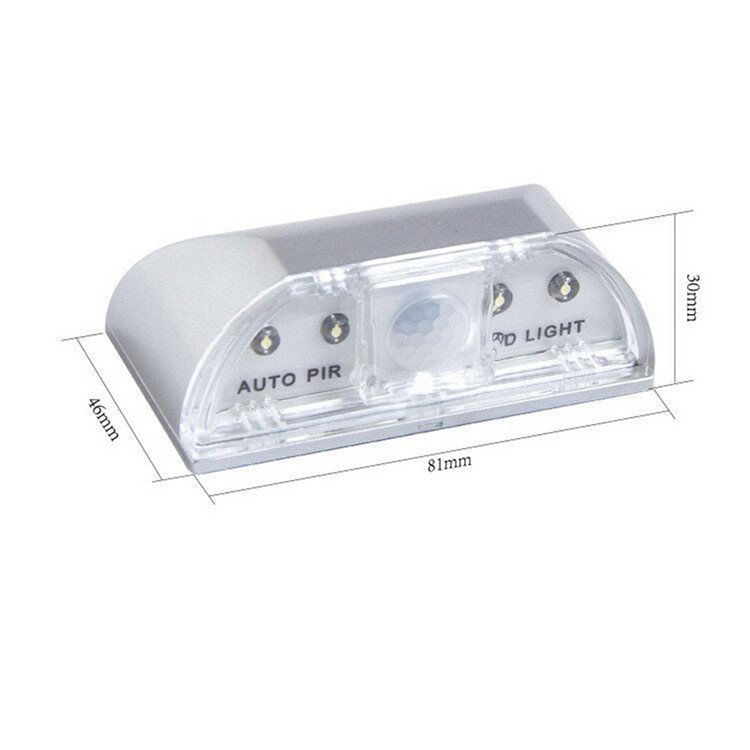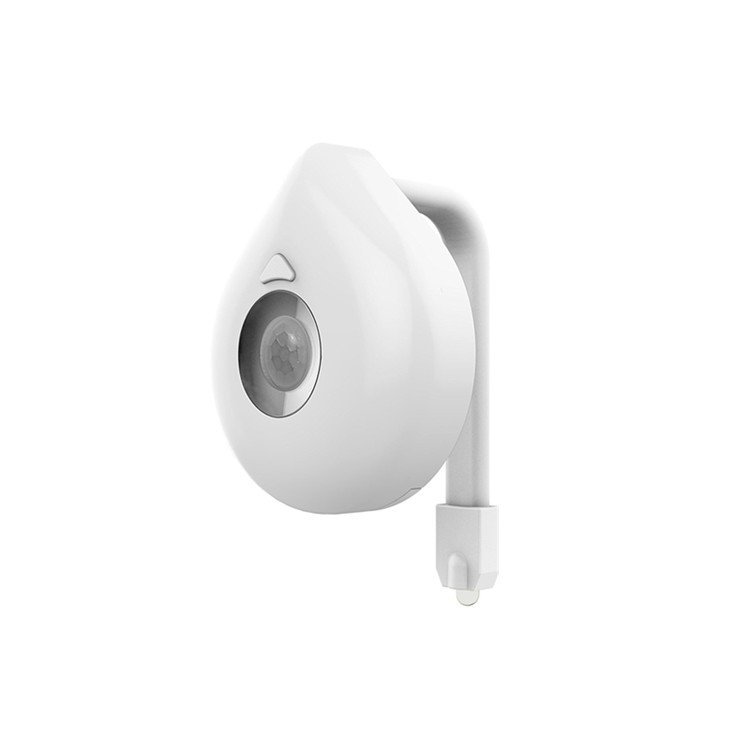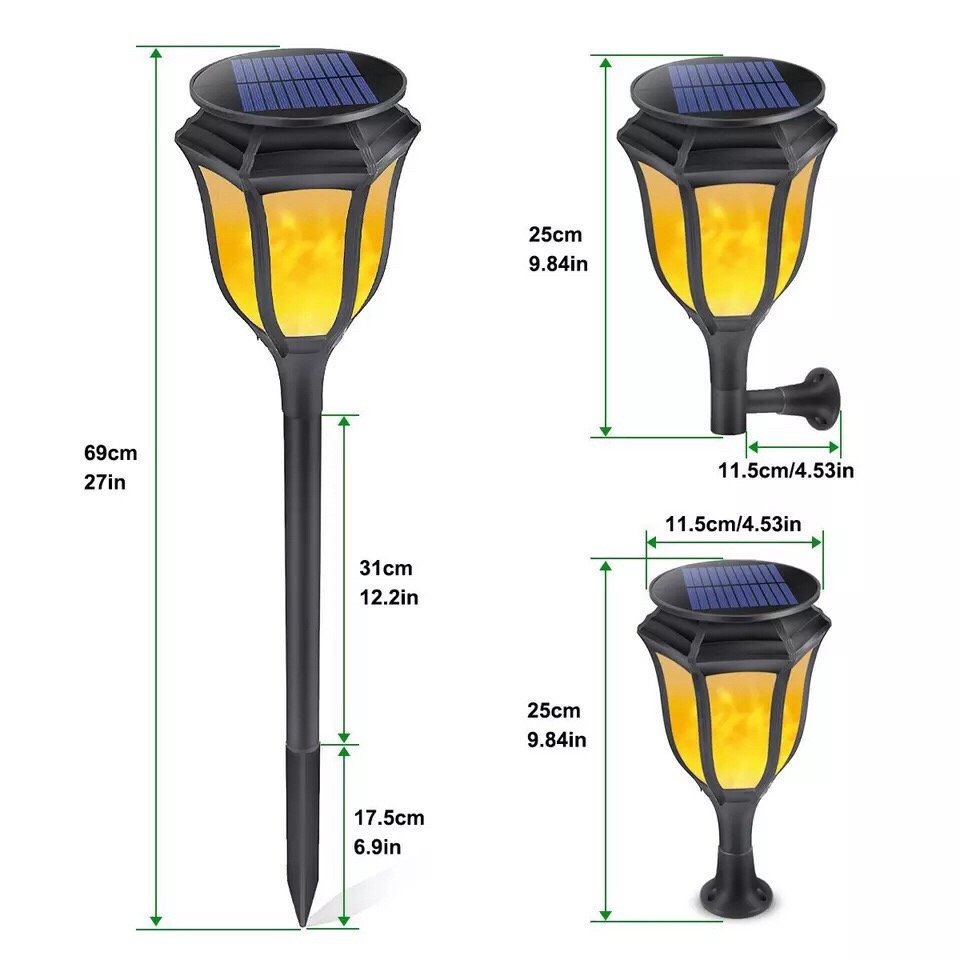Why GoldMore LED Sensor Light
- Goldmore LED motion sensor lights provide a convenient way to light halls, stairs and anywhere safety lights are periodically needed.
- 2 Years Warranty For LED Sensor Light Battery, These battery operated motion lights will operate for 1 to 2 years under normal use and employ the latest LED technology in motion sensor lighting.
- Prevalent in Households Across America, Motion sensor outdoor lighting is also becoming more and more prevalent in households across America due to its convenience and efficiency. Equip your household with Goldmore high-quality LED motion lights today.
- automatically turn on when passing within 9 feet of the sensor
- Automatically turn off after 15 seconds
- Battery powered: No wiring required, operated by 3x 1.5V AAA batteries (NOT included)
- Lightweight: Portable design
- Automatically powers off after 15-30 seconds of inactivity
- Powered by 3 x AAA batteries per motion sensor
- Automatically turn on when motion is detected within a 7-10 ft. range
- Lumens: 20, last up to 10,000 hours
- Automatically identifies the human body
- Automatically turn on and auto-off after about 5 seconds
- Working temperature -5′- 38’C
- The battery lasts a long time
- Automatically turn on
- Ultra-water resistant and can be cleaned with most household cleaners.
- Easy to Install and Clean
- Stay on for 2 minutes after the last movement
- Automatically turn on
- 8 colors
- Ultra water resistant & easy clean
- Can be installed at any edge of the toilet
- Auto-on within 10 feet, auto-off after about 25 seconds of no motion detected.
- With 10 LED in each light
- Easy to install
- Warm prompt
Are you looking for the professional LED sensor light manufacturers ? then you’ve come to the right place .Goldmore has been in LED sensor light field for more than 10 years . All of our LED sensor lights have passed the main testing like CE,ROHS ,UL ,EMC etc..
we can supply all kinds of led sensor lights such as LED motion sensor light,led solar sensor light,led toilet sensor light,PIR Motion Sensor night Light and more,just email us for more designs.




- Certification
Goldmore: Your Best LED Sensor Light Manufacturer in China
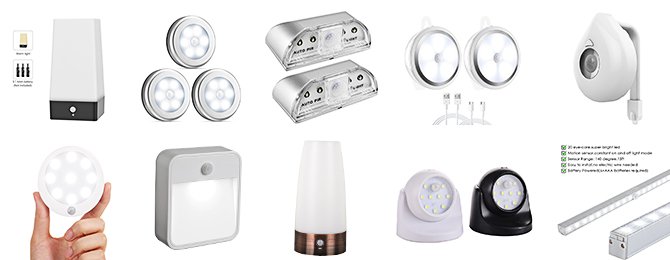
GoldMore LED sensor light provide a convenient way to light halls, stairs and anywhere safety lights that are constantly needed. GoldMore offer a full assortment of LED sensor light products which couple clever sensor technology with ultra-efficient LED modules.
GoldMore LED sensor light provides greater energy saving benefits by ensuring that your lights are only on when you need them. LED sensor light in GoldMore has the highest waterproof rating of any lights on our list. These lights are water resistant and can withstand both extreme cold and extreme heat.
Whether you require outdoor fixtures which will illuminate your driveway when you come home from work, or twilight detection sensor which only turn on when light levels are low, GoldMore LED sensor light can satisfy your needs.
Aside from the large selection of our LED sensor light, we can also customize design, style, packaging design, shapes, colors, etc that suit your business requirements.

For more than 10 years, GoldMore has been the leading manufacturer of LED sensor light in China. All of our LED sensor lights have been certified by an authoritative testing authority and have passed additional internal tests exceeding the industry ANSI/NEMA fl-1 standard.
If you are looking for the best LED sensor light, you can choose from the wide selection of LED sensor light GoldMore supplies. We provide more than 1000 LED sensor light products for you. Equip your household with GoldMore highest-quality LED sensor light.
GoldMore can provide you the most professional services for all your LED sensor light orders. We also offer a 2 years warranty for the LED sensor light battery.
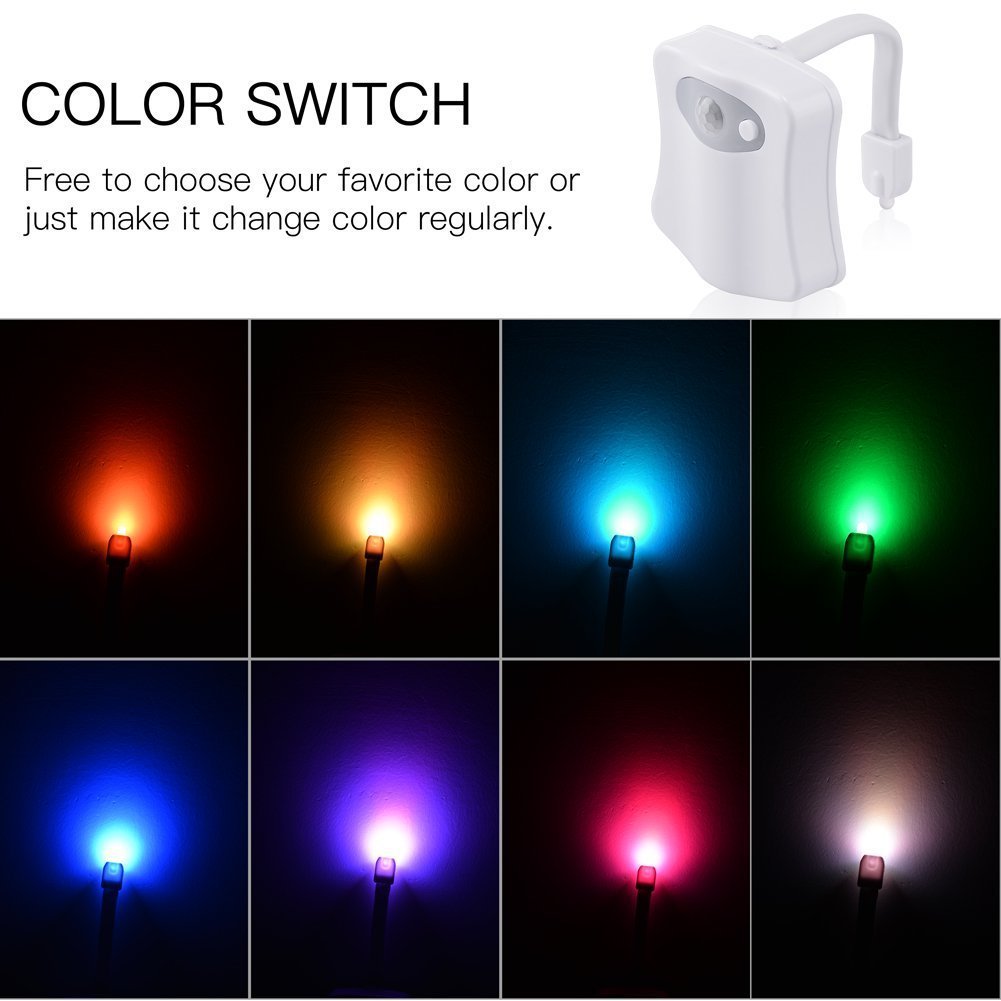
We, at Goldmore keep on providing each of our guest with unique lighting solutions. Whether to support their start-up business or providing the convenience and efficiency of their household. Send us your idea and we will make the perfect LED sensor light for you!
The Definitive Guide to LED Sensor Lights
- Why are sensor lights better than regular LED lights?
- Do LED sensor lights work during the day?
- Is there a way to reset sensor lights?
- What problems are common with LED sensor lights?
- Is there a way to control nuisance activation?
- How long do LED sensor lights stay on for?
- Up to what distance can sensor lights detect motion?
- What beam angle and detection range do I need?
- In sensor lights, are beam angle and detection angle the same?
- Is there a way to increase the beam angle?
- Does the outside temperature matter?
- Is there a difference in the design of indoor versus outdoor sensor lights?
- What are some types of indoor sensor lights?
- What are some types of outdoor sensor lights?
- Are there different light colors available for LED sensor lights?
- Is there a lesser known type of LED sensor lights?
- Where should LED sensor lights be installed outside?
- How many lumens should LED sensor lights have?
- How is motion detected in LED sensor lights?
- How can the sensors tell that an object is moving?
- Which is better: wired or wireless LED sensor light?
- Are there COB sensor lights?
- How can sensor lights be installed?
- How are LED sensor lights charged?
- Who are LED sensor lights for?
Why are sensor lights better than regular LED lights?
Firstly, they save more power and are eco-friendly since they only turn on when needed and for a few moments.
Secondly, they are very practical for security and workshops.
Driveway sensor lights will scare away potential burglars, solicitors, and animals.
Garage sensor lights are useful when you or your customers are carrying something and can’t turn the light on themselves.
When used as night lights, they will turn on when someone is walking around or moving, but turn off and won’t disturb their sleep.
Sensor lights are also great for safety around pools and stairs.
They don’t require much maintenance after the initial set-up.
You or your customers wouldn’t need to think about the lighting – sensor lights do everything on their own.

The attributes of a sensor light
Do LED sensor lights work during the day?
No, photocells react to daylight and keep the sensor light off.
When it gets dark, the light starts responding to motion.
Is there a way to reset sensor lights?
Sometimes the light will stay on even when there is no one around.
This happens when the detector senses something moving.
You can turn it off and back on after 20 seconds to reset the detector.
This will help reset the light as well.
What problems are common with LED sensor lights?
Some common problems include the light turning/off on for no reason, the light staying on longer than necessary, the light flickering.
When the light turns on too much, it is called nuisance activation.
It happens when the sensor is too sensitive and reacts to anything moving, such as a branch or a bird.
This is the most common problem with LED sensor lights.
It could also happen if the sensor picks up gusts of hot air or experiences electric interference.
When the light stays on for longer than necessary, then it could just be repeatedly stimulated, which is also a sensitivity issue or a power surge.
When the light turns off all the time, then the sensitivity may be too low.
When the light cycles on and off, then the photocells that differentiate between day and night may not be calibrated properly, so the LED’s own light may be tricking it and turning it off.
To see more problems, and causes visit the Home Depot page.
You can find some solutions to these problems as well.
Is there a way to control nuisance activation?
There are LED sensor lights with a pet immune feature.
They allow you or your customers to set up the size or weight of the object the sensors should look out for.
Thus, they will ignore something the size of a dog, but react to a moving human-sized object.
Another way to have pet immunity is not to angle the light downwards.
Then it will only react to objects the height of a human.

The pet immune feature
How long do LED sensor lights stay on for?
Depending on their application, the “on” time may vary.
However, usually, it can be from 5 seconds to 2 minutes to as long as there is motion.
Five-second lights are great for hallways or outdoor paths where you don’t need illumination for a long time – where you just need it to pass by.
Two-minute lights can also be used in hallways, on paths.
They can also be installed on stairways where you need light for longer periods of time.
Also, sensor lights for security purposes should stay on for longer to scare away intruders and help the homeowner see them before they disappear.
The lights that stay on for as long as there is motion are the most versatile but can take up more battery.
These are great for workshops and garages, as well as security lights.
Other timed lights can be stimulated repeatedly, but they will still turn off for a moment before lighting up again.
Up to what distance can sensor lights detect motion?
Most motion sensor lights have a semicircular field of view that can catch movement up to 240 degrees around the sensor and up to 70 feet (21 meters) in distance.
On some lights, you can actually set up the sensing range to what you need.

Sensor detection range and lighting distance
What beam angle and detection range do I need?
If you need to illuminate a doorway, then you should have a narrow beam and detection angles, and a short range.
Then, the chance of a nuisance activation is lower.
However, if you need a security floodlight, then you should request along – up to 70 feet – detection range, as well as a wide beam and detection angles.
In sensor lights, are beam angle and detection angle the same?
Not necessarily. You can request for the two to match, but these are two different systems.
The characteristics of each depend on your desired effect.
Thus, you can have a wide detection range on a spotlight or a narrow range on a floodlight.
Goldmore will be glad to answer your questions!
Is there a way to increase the beam angle?
The easiest way to increase either the beam angle or the detection range is to increase the number of light fixtures or sensors.
You will have areas of overlap, but you will increase the area of coverage.
This is perfect for security lighting.
Also, this way you can even have 360-degree coverage if you mount the lights around a pillar or a pole.

LED sensor light with 2 and 3 light fixtures to increase beam angle and brightness.
Does the outside temperature matter?
Some LED sensor lights have a set working temperature.
Contrary to the expectation, LED lights to work better in cold temperatures – lumen output increases and so does efficiency.
The limiting factor here is high temperature.
If the temperature is too high, the LED starts slowly fading due to overheating.
Thus, if you are buying or selling lights in hot environments, be cautious.
However, with a good heatsink, the light’s working temperature can be increased.
Some Goldmore lights can withstand up to 38°C.
Is there a difference in the design of indoor versus outdoor sensor lights?
Both indoor and outdoor lights need different designs.
Indoor lights can be smaller, USB-powered, less protected.
They just could be water-resistant from splashing water and moderately protected against dust ingress.
Also, indoor sensor lights could be more decorative and provide less lumens.
Outdoor lights should be bigger, provide more light, have either a solar panel or a large battery, and have a high IP rating, such as IP65.
These need to focus on practicality more than decor.
What are some types of indoor sensor lights?
LED sensor lights are usually small and neat.
They can be circular, square, strip, rod-shaped, as well as made to look like a stylish lamp.
Circular and square sensor lights both have the same applications.
They can be used to light up a closet or a drawer when you open it.
It can also be put on the wall or stairs to light up hazardous home locations.
They can be either on their own or with a base.
If they don’t have one, they can be installed anywhere.
But if they do, then they can be set up on a table or a ledge.
Some lights with a base have a sticky surface so you can install them anywhere as well.
Lights with bases can usually rotate and change the angle, which is versatile.

An adjustable light with a base
LED strip and rod-shaped lights can be a decorative addition to modern design.
They can be of any width or length, and they provide uniform lighting.
These can also be put in closets, stairs, and kitchen nooks.
Plus, they can be used to line the perimeter of a room or a large piece of furniture.
For example, these can be put under the bed so that when a person wakes up at night, the lights will turn on for them.
LED strip lights are especially versatile because they are flexible and malleable, so you can create any shape with them.
Also, they are more likely to have color options.

LED strip lights
LED sensor lights can also look like regular lamps to be set on the table or anywhere else to be used as a night light or even a patio light.
Some indoor lights have hooks, allowing you to hang them anywhere and change their location all the time.
A popular type of an indoor light with a hook is a toilet light.

An indoor LED sensor light with a hook
For more ideas, visit our catalogue.

Different ways to use indoor sensor lights
What are some types of outdoor sensor lights?
Outdoor sensor lights can be floodlights or they can be decorative lights.
They can also be used as garden lights.
Some popular places to put outdoor sensor lights are driveways, doorways, patios, pools, boathouses, and much more.
For security and safety, big solar-powered floodlights are best.
For decorative reasons, smaller lights are best.
They can be flood- or spotlights, even remote lights.
All outdoor lights are usually mounted on the wall, so they all look similar, except for decorative sensor lanterns.
Another type of decorative light is a free-standing lamp sensor light that you can put on a patio table or a ledge.
Also, there are sensor lights with live view cameras, which is perfect for security.

A decorative sensor lamp
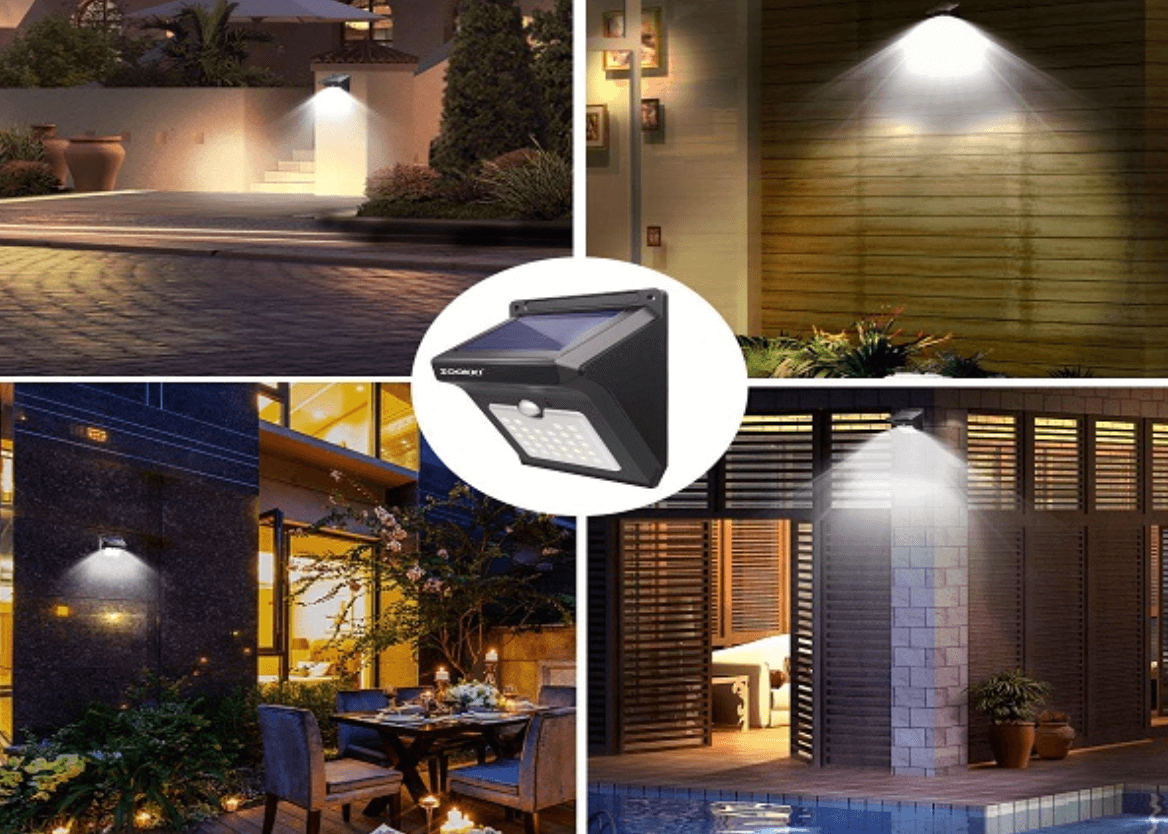
Different ways to use outdoor sensor lights
Are there different light colors available for LED sensor lights?
In terms of color temperature, neutral white and cool white from 5000K to 6000K is the best for outdoor sensor lights.
These color temperatures are bright.
If the lights are used for security, then a cooler color would work since it is harsh on the eyes and would disturb any intruder.
For indoor lights, you can use any color temperature, but neutral white is better if you want to illuminate a staircase or a closet since warm light isn’t as bright and may distort colors.
Indoor lights – especially toilet lights – can also be of any color according to your taste.

Different colors you can choose from
Is there a lesser known type of LED sensor lights?
There is a remote LED sensor light. This is a 2-part appliance that has a remote sensor and lights that are installed separately.
Once the sensor detects movement, it sends a radio signal to the receiver.
This receiver turns the light on.
The remote can be up to 100 feet (30 meters) away from the light fixture.
This could be useful if you don’t want to clutter the design or want the LEDs to light up ahead of time, like if you are rounding a corner on the path.

A remote sensor light
Where should LED sensor lights be installed outside?
Indoor lights are more obvious on where to put them – closets, stairs, drawers, anywhere.
However, outdoor lights are more vague on that.
Generally, you would put sensor lights to illuminate paths, gates, pools, patios, and stairs.
In terms of a specific location, the light should be installed 6-10 feet (2-3 meters) off the ground.
Also, it should be somewhere that potential movement will go across the detecting area rather than towards it.

Places where outdoor sensor lights can be installed
How many lumens should LED sensor lights have?
Outdoor lights should have more lumens than indoor ones.
Generally, path sensor lights should have at least 100 lumens.
Floodlights should have about 600-700 lumens.
Various indoor lights could be anywhere from 20 to 70 lumens.
How is motion detected in LED sensor lights?
There are different types of lights that use different technologies to detect motion.
A microwave technology sends microwave pulses and analyses the reflected waves for motion.
This technology is expensive, but it covers a large area, which is great for a security floodlight.
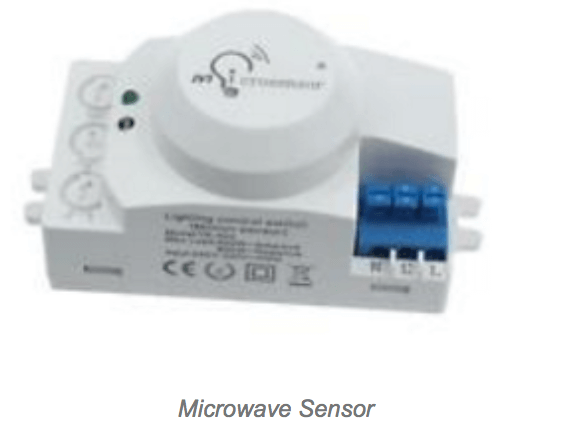
Passive infra-red (PIR) technology detects heat and analyses the movement of it.
If it is body-like, then the sensor will “trip” and turn on the light.
This technology is the most common one in motion sensors.
It doesn’t emit waves, just catches them.

n the contrary, the area reflective technology emits infra-red rays and analyzes the return waves to motion.
The ultrasonic technology uses high-frequency sounds that are bounced off of moving objects to trip the light.
These sounds can also double as animal repellers, but if you or your clients own pets, they will be very bothered.

A vibration technology uses a lightweight lever that moves when there is vibration, such as from footsteps.
This movement turns the light on.
Tomographic sensors emit radio waves.
These work over very large areas, but they can also sense through walls, which is not useful for domestic purposes.
However, they could be great for warehouses.

Finally, the dual detect technology uses a combination of other ones for more accurate performance.
This way, the light will turn on when there is an actual person moving, not just when a branch moves.
This is extra expensive, but it is also more useful and more energy-efficient.
Most of these lights work by the same principle, just using different waves.

How sensor lights detect motion
How can the sensors tell that an object is moving?
The sensors analyze the environment for heat radiation or various waves.
Based on how these waves reflect off of objects, the sensor interprets movement.
This depends on how fast the waves are reflected, how strong they are, how does the angle at which they have reflected changes.
Essentially, they analyze the interference that objects create and how this interference behaves.

The sensor analyzes the angle of reflected waves
Which is better: wired or wireless LED sensor light?
Both of these have their benefits.
Generally, wireless sensor lights allow flexibility in installation.
They are easy to mount and experiment with placement. However, they cover a much smaller area.
Wired sensor lights are more difficult to install, but they cover a much larger area.
Are there COB sensor lights?
Yes, there are. But, COB is used mostly with outdoor sensor floodlights, rather than with indoor lights.
You can have COB indoor lights, but surface-mounted LEDs and 5mm LEDs are more common.
This is because the COB technology provides brighter light, which is needed outside but not at home.

A COB outdoor sensor light
How can sensor lights be installed?
LED sensor lights can be installed by just applying them to the wall or by wiring them in.
Indoor lights usually can just be taped onto the wall or drilling in the fixture.
Outdoor lights will usually need a more involved wiring through a small electrical box in the hole of the wall.
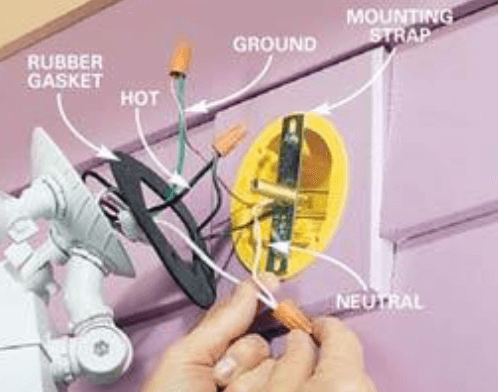
Mounting an outdoor light
How are LED sensor lights charged?
Just like with other LED lights, you can request a battery, a USB port, a solar panel, or a cord with a plug.
Outdoor lights should be solar, if possible, but if not, then they should have a large battery.
However, if the lights will be in a cold environment, then the traditional cord and plug is best.
Indoor lights should be solar or USB-powered.
Since they are small, there is no need for a cord and plug.

LED sensor lights powered through different USB systems
Who are LED sensor lights for?
They are for practical people.
Even decorative sensor lights are still very practical.
Sensor lights are also for busy people who don’t want to think twice about lighting.
Finally, they are for people that want security and protection.
We can cater and you can market LED sensor lights to these kinds of people.
If you are interested, contact Goldmore today!




